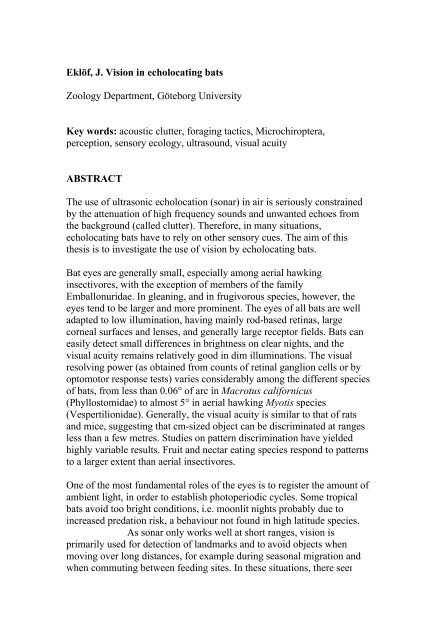Vision in echolocating bats - Fladdermus.net
Vision in echolocating bats - Fladdermus.net
Vision in echolocating bats - Fladdermus.net
Create successful ePaper yourself
Turn your PDF publications into a flip-book with our unique Google optimized e-Paper software.
Eklöf, J. <strong>Vision</strong> <strong>in</strong> echolocat<strong>in</strong>g <strong>bats</strong><br />
Zoology Department, Göteborg University<br />
Key words: acoustic clutter, forag<strong>in</strong>g tactics, Microchiroptera,<br />
perception, sensory ecology, ultrasound, visual acuity<br />
ABSTRACT<br />
The use of ultrasonic echolocation (sonar) <strong>in</strong> air is seriously constra<strong>in</strong>ed<br />
by the attenuation of high frequency sounds and unwanted echoes from<br />
the background (called clutter). Therefore, <strong>in</strong> many situations,<br />
echolocat<strong>in</strong>g <strong>bats</strong> have to rely on other sensory cues. The aim of this<br />
thesis is to <strong>in</strong>vestigate the use of vision by echolocat<strong>in</strong>g <strong>bats</strong>.<br />
Bat eyes are generally small, especially among aerial hawk<strong>in</strong>g<br />
<strong>in</strong>sectivores, with the exception of members of the family<br />
Emballonuridae. In glean<strong>in</strong>g, and <strong>in</strong> frugivorous species, however, the<br />
eyes tend to be larger and more prom<strong>in</strong>ent. The eyes of all <strong>bats</strong> are well<br />
adapted to low illum<strong>in</strong>ation, hav<strong>in</strong>g ma<strong>in</strong>ly rod-based ret<strong>in</strong>as, large<br />
corneal surfaces and lenses, and generally large receptor fields. Bats can<br />
easily detect small differences <strong>in</strong> brightness on clear nights, and the<br />
visual acuity rema<strong>in</strong>s relatively good <strong>in</strong> dim illum<strong>in</strong>ations. The visual<br />
resolv<strong>in</strong>g power (as obta<strong>in</strong>ed from counts of ret<strong>in</strong>al ganglion cells or by<br />
optomotor response tests) varies considerably among the different species<br />
of <strong>bats</strong>, from less than 0.06° of arc <strong>in</strong> Macrotus californicus<br />
(Phyllostomidae) to almost 5° <strong>in</strong> aerial hawk<strong>in</strong>g Myotis species<br />
(Vespertilionidae). Generally, the visual acuity is similar to that of rats<br />
and mice, suggest<strong>in</strong>g that cm-sized object can be discrim<strong>in</strong>ated at ranges<br />
less than a few metres. Studies on pattern discrim<strong>in</strong>ation have yielded<br />
highly variable results. Fruit and nectar eat<strong>in</strong>g species respond to patterns<br />
to a larger extent than aerial <strong>in</strong>sectivores.<br />
One of the most fundamental roles of the eyes is to register the amount of<br />
ambient light, <strong>in</strong> order to establish photoperiodic cycles. Some tropical<br />
<strong>bats</strong> avoid too bright conditions, i.e. moonlit nights probably due to<br />
<strong>in</strong>creased predation risk, a behaviour not found <strong>in</strong> high latitude species.<br />
As sonar only works well at short ranges, vision is<br />
primarily used for detection of landmarks and to avoid objects when<br />
mov<strong>in</strong>g over long distances, for example dur<strong>in</strong>g seasonal migration and<br />
when commut<strong>in</strong>g between feed<strong>in</strong>g sites. In these situations, there seems<br />
4


